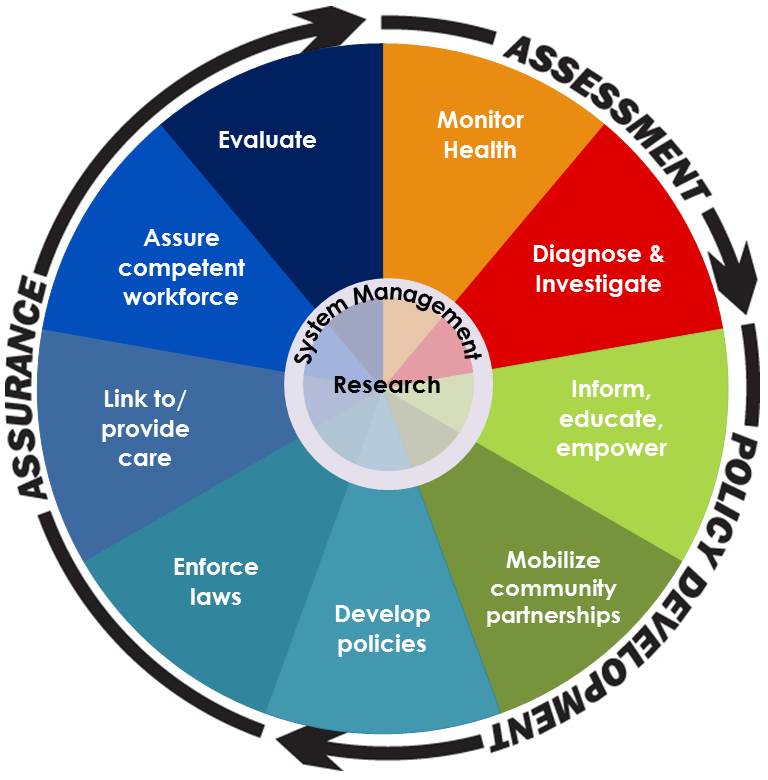See who is eligible to get a vaccine now. Registration for people 75 and older will begin on January 25. Sign up to get weekly email updates!
How Are We Doing? Performance Scorecards
How Are We Doing? Performance Scorecards

performance management & scorecards
The Health Department actively uses performance data to improve the health of Vermonters. We want to know how well we and our partners are performing, so we can adjust public health strategies accordingly.
This involves the strategic use of performance standards, measures, progress reports, and ongoing quality improvement efforts to ensure we are achieving desired results. The performance management framework guides our efforts.
The Health Department performance management framework helps organize this effort by integrating with the State Health Assessment, State Health Improvement Plan, outcomes-based legislation (Act 186), and core departmental operations. It functions at the program, organization, and system level to ensure the Health Department is using performance data in decision making. This work is overseen by the performance improvement manager and the Performance Management Committee, which has representation from across the department. Population health status accountability and strategic planning set direction and identify outcomes.
There are six components of the performance management framework that guide performance management:
- Program performance accountability quantifies and reports how Health Department programs are functioning.
- Public Health Stat is an internal management process facilitated by the performance improvement manager that promotes data-driven decisionmaking, relentless follow through, and a focus on accountability. Stat engages managers at all levels in developing and owning solutions that are data-driven with an eye toward achieving efficiencies that will positively impact health outcomes.
- Continuous quality improvement is accomplished through the Agency Improvement Model, a Plan-Do-Study-Act cyclical process improvement model.
- Performance-based budgeting ensures that sub-grants and sub-contracts align partner and vendor work with public health priorities.
- Staff and workforce performance evaluations promote individual understanding and alignment with outcomes. Performance management was noted as an Area of Excellence by the PHAB Accreditation Committee – specifically the Healthy Vermonters 2020 performance management system and Public Health Stat.
- Staff and workforce performance evaluations promote individual understanding and alignment with department outcomes.
Performance management was noted as an Area of Excellence by the PHAB Accreditation Committee, specifically the Healthy Vermonters 2020 performance management system and Public Health Stat.
The performance scorecards measure our efforts. These interactive report cards show how well Vermont is doing compared to our desired outcomes. Scorecards display statewide population data and program performance measures that support transparent and accountable government. They are built according to Results Based AccountabilityTM and together provide decision-makers with a consistent way to use data to manage performance.
In contrast, the Public Health Data Explorer is the primary tool for accessing regional population data with maps, trends, and community profiles. At this time, the Data Explorer does not focus on performance but may be beneficial in your data-driven discussions.
Performance Scorecards
Healthy Vermonters 2020 is one framework through which the Health Department has organized performance scorecards and the complementary Public Health Data Explorer. Both have topic-specific reports with statewide population data. The scorecards also have performance measures about how the State of Vermont and partner programs are performing. As represented here, most program performance data are from the Health Department, but the scorecards continue to involve and display integrated, cross-sector work to improve health.
There are 21 Healthy Vermonters 2020 Performance Scorecards:
Environmental Health & Food Safety
Immunization & Infectious Disease
Physical Activity, Nutrition & Weight
Communities all across the state have been facing the challenge of opioid addiction. The scorecard reflects how are we doing at preventing, screening, intervening, treating and helping Vermonters in recovery.
3 behaviors (smoking, physical inactivity and poor nutrition) cause four diseases (diabetes, cancer, heart disease and lung disease), resulting in more than 50% of deaths in Vermont. The scorecard reflects how we and our partners are doing at prevention.
The Health Department’s Vector-borne Disease Program tracks and responds to diseases carried by mosquitoes, ticks, and other vectors.
In This Section
3 behaviors (smoking, physical inactivity and poor nutrition) cause four diseases (diabetes, cancer, heart disease and lung disease), resulting in more than 50% of deaths in Vermont. How are we and our partners doing at prevention?
Access to health services is about more than having health insurance. How are we doing with access to care?
How well are we doing in preventing/treating alcohol and drug abuse?
How many people are diagnosed – or aware of how to prevent, treat or manage their condition?
Are recommended screenings being utilized, survivors living well longer, deaths from cancer decreasing?
How many people living with diabetes have the education and care they need to live well longer?
Are babies and young children getting the screenings they need to detect and treat health problems early?
How are we doing at promoting policies that ensure Vermonters can grow up, live and work in a healthy environment?
How are we doing to help women and families plan for a healthy pregnancy?